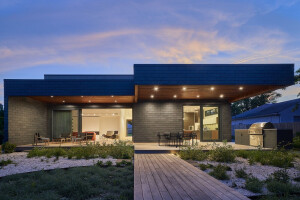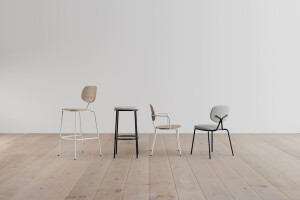Courtyard House: De Rosee Sa Convert Redundant Garage Site Into Bespoke Family Home De Rosee Sa have recently completed a house on the site of a former wood yard between rear terraced gardens and a row of 16 West London garages. The client lived across the road from the existing storage shedand originally bought the site to prevent it being overdeveloped.
Seeing a possible opportunity, the client decided to develop the land themselves, in line with the planning regulations. Planning restrictions set a vertical limit to the height of the property, stipulatingthat any form must match the outline of the existing single-storey shed. It was necessary to agree twenty-one party wall awards with neighbouring properties before works could start on site.
De Rosee Sa proposed a new basement level to meet the client’s brief for a two-bedroom house. The ground floor is divided between living room, kitchen and bedroom with an en-suite bathroom, the second bedroom is located in the basement level with its own external courtyard and bathroom.
Inserting windows into the boundary wallswas not possible as they were party walls. As the site is 37metres long, the design includes three external courtyards to draw light into the house. A series of Crittal style steel and glass doors connect these courtyards with the interior spaces of the house, providing views through the length of the house. In good weather, the house can be opened up, allowing air in and blurring the distinction between outside and inside further.
Generally the internal walls of the courtyards are clad in Western Red Cedar battens in reference to its history as a timber storage yard. The cedar batterns continue to the inside surfaces to form two cedar clad ‘volumes’ that contain smaller functional spaces (WC, study niche and utility room). The cedar cladding was chosen for its texturalquality that softens the minimal, white interiors.
The clients have sold their existing house and are now living in the Courtyard House.
Max de Rosee, Director of De Rosee Sa Architects, said: “We worked very hard in the initial stages to convince the clients that developing this house was a risk worth taking. We had to convey its potential.
We wanted to contrast the crisp white walls and ceiling with some strong materials so we spent a considerable amount of time considering the detail of the western red cedar batterns and granite setts in the courtyard surfaces.
The most satisfying aspects of the project is the top light that pours into the interiors and the long views through the courtyards. Once inside, you forget that thishouse is in London.
These kinds of opportunities are rare; we were lucky as the clients were very encouraging especially once the spaces started to emerge. It sounds clichéd but I really believe the result is due to a successful collaboration between the architects and the clients.”














































